Photos and article by Joseph Sapia
Afield observations made in the Pine Barrens around Helmetta in South Middlesex County. Garden observations made in my yard, just outside of Helmetta.
THE GARDEN. Planted vegetables, cantaloupe, and flowers, all from seed, May 21. Sweet corn, cucumbers, and sunflowers are sprouting well. The tomatoes are just peeking through the soil.
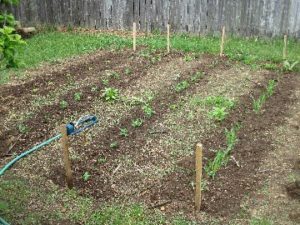
GARDENING CHORES. Planted black-eyed Susan seeds, finished lawn-mowing, weeded the garden, been watering the garden.
WATERING THE GARDEN. I use no fertilizer and no chemicals — to me, things ruining the local Pine Barrens ecosystem and time bombs in the soil and groundwater. But I water, a soaking preferably before 10 a.m., so less loss of water to evaporation in the sun’s heat and allowing the vegetation to dry so as not to pick up fungal growth. If I miss the pre-10 a.m. watering, I will try to water with a sprinkling can, low to the ground, underneath the vegetation.
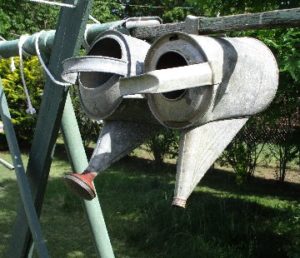
WATER CONSERVATION. Since taking over the family house in 2002, I have cut my water consumption in half for the most part. Some can be attributed to a needed bathroom remodeling (and a water-efficient toilet), but a lot is from simple conservation — do not run as much water, along with re-using gray water and rain water for watering plants. This week, for example, I watered the garden with a combination of house water and gray water, hoping to switch entirely to rain water and gray water.
MORE WATER CONSERVATION. Water from the cellar de-humidifier goes to the bird bath/watering trough. The trough, too, is recycled — a garbage can lid place on the ground, easy for birds to use, as well as squirrels and so on.
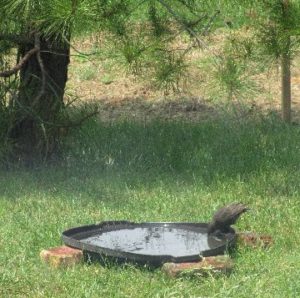
RACCOON AT THE BIRD-FEEDER. My friend continues to visit the bird-feeder, helping itself to the sunflower kernels. I let it do it for a good part of the night, then I put the feeder in the garage for the overnight.
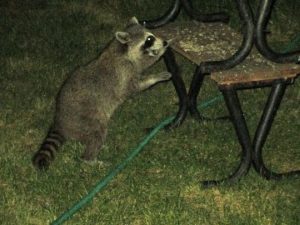
WILDLIFE AND ME. Un-rhythmic chirping crickets in my cellar in the middle of the night bring out the serial killer in me — wait till later this summer when that starts up!. But, generally, wildlife is very welcome in my yard (if not my house). This week, though, a raccoon, which I normally get within 7 or so feet of as I let it raid my bird-feeder, would not leave my garage after I startled it and it hid behind tools and so on. I poked around with a stick and finally gave up, left the doors open, and curled up on the love seat in the house until I heard rattling, meaning the raccoon was in the garbage can holding the bird seed. So, I got up, and shooed it away. Earlier, while weeding, I saw a rabbit — whose kind let me get within 5 feet or so — eating my sunflower sprouts. The hand-weeder in my hand flew across the garden. Get it? The rabbit surely understood.
WILD ON MY SIDE. Neat on the street side and neighbor side. I let my hedges and shrubs have a wild or English garden look facing inward. But I try to keep it neat on the public and neighbors’s sides. And I keep a number of wild patches in my side and back yards, making the best out of unproductive lawn ecosystems (photo 9) (I am puzzled by parents that worry about school bus stops, un-shoveled snowy sidewalks, and overcrowded classrooms, but do not worry about the chemicals on their lawns. Time bombs, I say, time bombs!)
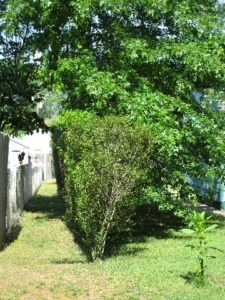
AROUND THE YARD. The season’s first bloom of Knock Out roses is wilting. Fungi (photos 11 and 12), mullein, and pokeweed sprout freely. I let this stuff grow, interested in how it looks.
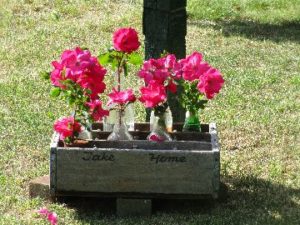
— WHAT IS GOING ON? In recent weeks, I have seen a brown thrasher (first I have seen in around 15 years), then I heard a whip-poor-will calling at my house (the first in an estimated 6 years), and, this year, the northern gray treefrogs have been hollering. Is nature coming back to the local Pine Barrens? Is the natural world becoming so condensed that nature is retreating internally? Does it mean anything?
— AND MOUNTAIN LAUREL IS BLOOMING Meaning turtles are out laying eggs, so be careful while driving. (And be careful: Do not pick them up by their tails and WATCH OUT FOR THE SNAP OF A SNAPPING TURTLE.) For the more fainthearted naturalists, the mountain laurel blooming is sort of an alarm clock that the woods will heat up, get muggy, and pine flies will be swarming.
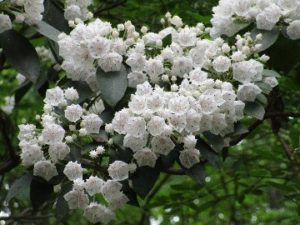
— MY INSIDE GARDEN. The view from my desk.
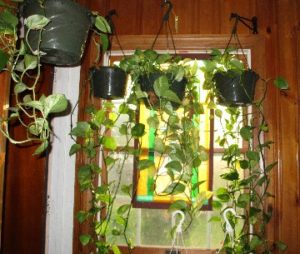
Copyright 2016 by Joseph Sapia
Joe is kicking off a new Facebook.com group, “The Jersey Midlands,” where this report is first published. To access The Jersey Midlands, go to the group and request access.
Joe Sapia, 59, is a vegetable gardener, who gardens the same backyard plot as did his Italian-American father, Joe Sr., and his Polish grandmother, Annie Poznanski Onda. Both are inspirations for his vegetable gardening. And he draws inspiration on the local Pine Barrens from his mother, Sophie Onda Sapia, who lived her whole life in the local Pines, and his grandmother.
Photos and text by Joseph Sapia
Garden and Afield in Helmetta-Monroe-Jamesburg, 2016, May 22, Sunday, to May 28, Saturday
From my yard in the Helmetta Road area of Monroe and the surrounding Pine Barrens
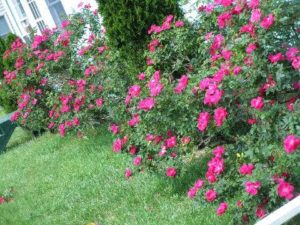
Knock-out roses
— “KNOCK OUT’ ROSES: The “Knock Out” roses are putting on a spectacular display, the best I recall since planting them in my yard in 2008.
— RACCOON/S AT THE BIRD-FEEDER: The battle continues between me and the raccoons at the bird-feeder. I have been putting the feeder in the garage at night, but the raccoon/s sometime beat me to the feeder.
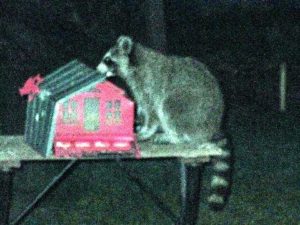
Raccoon at my backyard birdfeeder
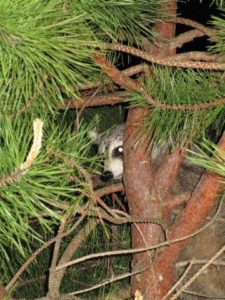
— CANADA GEESE GOSLINGS: Adult Canada geese are out and about with their goslings. The adults are amazing parents — and humans can learn from them, (Photo 6, at Helmetta Pond.)
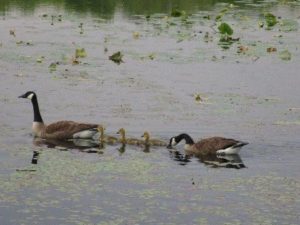
Canada Geese at Helmetta Pond
— NEW JERSEY STATE BIRD AT THE FEEDER: An Eastern goldfinch at one of my bird-feeders. Easily identified as a male because of the bright colors.
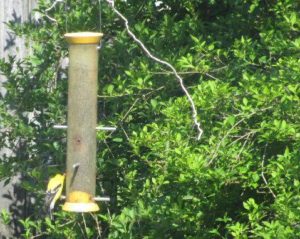
Eastern Goldfinch, the New Jersey state bird
— NORTHERN GRAY TREEFROGS: These called strongly during the week. See http://www.state.nj.us/dep/fgw/ensp/audio/no_gray_frog.wav.
— GARDEN: I planted May 21 and a week later plants were sprouting, most noticeable the Mammoth Gray-Stripe sunflower. Although I do not use fertilizer or pesticides, I water regularly. Once the plants get going, I water before 10 a.m. so as not to lose water to evaporation as the day warms.
— BLACK BEAR MOVEMENT: Reports continue about black bear sightings in Central Jersey and across the Delaware River in Pennsylvania. I am surprised there have not been more reports closer to home. If a bear is sighted, it is likely a 1-1/2-year-old male, perhaps 80 to 100 pounds, looking for its own turf. (What to do when encountering a bear, http://www.state.nj.us/dep/fgw/pdf/bear/bearfacts_know.pdf.)
— YARDWORK: I trimmed the shrubs, then started cutting the grass. I have to finish the lawncutting today. I still have to plant black-eyed Susans.
— BLAST FROM THE PAST, CIRCA LATE 1960S: Paul Migut with an 8-horsepower roto-tiller at his Uncle Stanley “Pon” Ceslowski’s garden on Old Road at Helmetta Road, Monroe. Over the years, Pon, Paul and Jim Becker worked that huge garden.

Paul Migut, circa late 1960s, at Pon’s garden
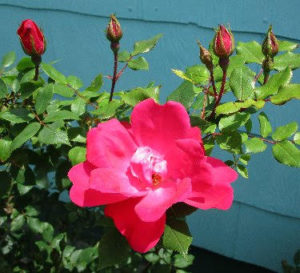
More knock-out roses
Joe Sapia, 59, is a vegetable gardener, who gardens the same backyard plot as did his Italian-American father, Joe Sr., and his Polish grandmother, Annie Poznanski Onda. Both are inspirations for his vegetable gardening. And he draws inspiration on the local Pine Barrens from his mother, Sophie Onda Sapia, who lived her whole life in the local Pines, and his grandmother.
The LRWP has submitted the following letter in response to NOAA’s Invitation to Public Comment on their “Restoration Plan/ Environmental Assessment Draft (RP/EA) for the American Cyanamid Co. Superfund Site, Bridgewater Township, Somerset County, New Jersey”:
May 23, 2016
Carl Alderson
NOAA Restoration Center – Sandy Hook Office
JJ Howard National Marine Fisheries Science Center
74 Magruder Rd, Highlands, NJ 07732
RE: American Cyanamid Draft RP/EA
Dear Mr. Alderson –
The Lower Raritan Watershed Partnership has reviewed NOAA’s proposed Restoration Plan/ Environmental Assessment (RP/EA) for the American Cyanamid Co. Superfund Site, Bridgewater Township, Somerset County, New Jersey and fully supports the proposal for primary and compensatory restoration activities.
The LRWP is New Jersey’s newest watershed association, formed in 2014 to address legacy contamination and current pollution in the Raritan River and the Lower Raritan Watershed. Our mission is to conserve, enhance and restore the natural resources of the New Jersey Watershed Management Area 9, the Lower Raritan Watershed. We believe that not only will removal of the Weston Mill Dam on the Millstone River directly improve resources impacted by legacy contamination, it is our understanding that the proposed project will benefit a broad spectrum of the Raritan River’s ecology and will likewise enable other environmental and human use benefits. Significant ecological, environmental and human use benefits have in fact already been realized following recent removal of a series of dams (Robert Street, Nevius Street and Calco) on the lower portion of the Raritan River between the towns of Bridgewater and Bound Brook. Likewise, we expect that design of technical fish passage at the Island Farm Weir (located on the Raritan River) will advance multiple Lower Raritan Watershed stakeholder goals.
The LRWP is also aware that the removal of the Weston Mill Dam on the Millstone River, as well as future modifications at the Island Farm Weir to include a technical fish passage at the Island Farm Weir on the Raritan River, will expand access to several thousand acres of non-tidal freshwater mid to upper reaches of the Raritan River’s major tributaries. Removal of Weston Mill Dam and the construction of a technical fish passage at Island Farm Weir will significantly enhance maturation and rearing habitat for striped bass, American shad, American eel, blueback herring, and alewife, and should significantly increase the abundance of anadromous and catadromous species, which will improve the ecological health of the Raritan River.
The LRWP’s only concerns with NOAA’s proposal are short term sediment transport impacts following dam removal. However, we are confident that NOAA’s plan to reduce potential environmental consequences is sound and further expect that the proposed projects will provide long term restorative benefits to water chemistry, specifically decreased water temperatures in formerly impounded sections, and increased dissolved oxygen concentrations. These changes will benefit riverine biota from the most basic food chain level up to the top predators for many years to come.
Enhancing fish populations in the Raritan River system is important for fresh and marine ecosystems. It is especially appropriate as the National Marine Fisheries Service (NMFS) lists the estuarine portion of the Raritan River as an important migratory pathway for anadromous alewife and blueback herring, species which NOAA lists as of special concern. The Lower Raritan Watershed Partnership feels that the proposed projects could help to reverse declining population trends, and anadromous fish returning to spawn each spring in the Raritan River provide an attraction to the general public in the Raritan River Basin. The removal of the Weston Mill Dam on the Millstone River and feasibility analysis and design of technical fish passage at the Island Farm Weir are important to the LRWP and we fully support the proposed projects.
Sincerely,
Heather Fenyk, Ph.D., AICP/PP
President, Lower Raritan Watershed Partnership
www.lowerraritanwatershed.org
The National Oceanic and Atmospheric Administration, the Department of Interior, and the State of New Jersey invite public comment on a proposed plan.
The Draft RP/EA is available at the following website:
http://darrp.noaa.gov/hazardous-waste/american-cyanamid
The public comment period on this plan ends June 10, 2016.
To request further information or an additional hard copy of this document or to submit your comments, please contact Carl Alderson at (732)371-0848, NOAA Restoration Center – Sandy Hook Office, JJ Howard National Marine Fisheries Science Center, 74 Magruder Rd, Highlands, NJ 07732 or by email at Carl.Alderson@noaa.gov. Please put “American Cyanamid Draft RP/EA” in the subject line.
Garden and Afield In Helmetta-Monroe-Jamesburg
2016, May 15, Sunday, to May 21, Saturday
by Joseph Sapia

Nearly a Full Corn-Planting Moon during the week
— NIGHT SKY: On Saturday, the moon turned full, the Full Corn-Planting Moon. Look for a bright red Mars for weeks. (The photograph is of the almost-full moon over Monroe and Jamesburg.)
— VEGETABLE GARDENING: I got the vegetable garden in on Saturday, May 21, working in and out of rain. I am a bit concerned I went by the calendar, using May 20 as my guide to when the soil normally would be warm enough to plant, rather than by this year’s still-cool weather. That is, the soil may still be too cool for the warm-season vegetable plants. Perhaps I should have waited to June 1. No matter if I went with my heart over my head, the crop is in: Mammoth Gray-Stripe Sunflower, Cuppa Joe Sweet Corn, Rutgers Tomato, Hale’s Best Jumbo Cantaloupe, Born-to-be-Mild Hybrid Hot Pepper, Kaleidoscope Mix Carrot, Northern X-tra-Sweet Hybrid Sweet Corn, Igloo Lettuce, Carnival Mix Sweet Pepper, and Tasty Green Cucumber.
— OLD SEEDS: The Mammoth Gray-Stripe Sunflower, Cuppa Joe Sweet Corn, and Tasty Green Cucumber are 2015 seeds, which still should produce a crop.
— HOW I SEED: For what it is worth, I do not single-seed. Instead, I place a few to a bunch of seeds per hole.
— POLLINATION IN THE VEGETABLE GARDEN: I am trying something new in the garden, adding flowers to attract pollinators. So, I threw around seeds of Burpee’s Bee and Butterfly Garden and Monmouth Conservation Foundation’s Project Pollinator/Kids for Conservation.
— GARDENING ZONES: As the area transitions from the cooler Zone 6 to the warmer Zone 7, because of global warming, we will have a longer growing season. The gardening downside, more erratic weather. For example, many days of rain, followed by long periods of droughty weather. And, of course, the environmental downside is the global warming.
— RACCOONS AT THE BIRD-FEEDER: I enjoy watching the nightly visit of a raccoon or raccoons at the bird-feeder, sometime joined by a skunk below the feeder. I guess the raccoons and skunk like the sunflower hearts/kernels I use – and they have to eat, too, while entertaining me. But I got tired of the raccoon/s knocking down the feeder night after night. So, for now, I am bringing the feeder inside the garage at night and putting it back out in the morning.
— BIRDS: House finches were flying around the yard, fluttering to trees, bird-feeder, and clothesline, having trouble landing. They must have been fledglings, trying to figure it all out.
— WHIP-POOR-WILL CALLING: About 10:45 to 11 p.m. Wednesday night, May 18, a whip-poor-will called loudly, if only sporadically. This was once a common bird here in the local Pine Barrens – calling ad nauseam through the overnight. But this one was the first I have heard in an estimated 6 years. I got reports of whip-poor-will calls from around my Helmetta Road neighborhood, so I hoping for a return of the whip-poor-will.
— MOUNTAIN LAURELS AND SNAPPING TURTLES: Mountain laurel should begin blooming about now. So, remember this bit of Pine Barrens lore: “The snapping turtle lays its eggs, when the mountain laurel blooms.” Watch for snappers crossing roads – probably a female headed to high ground from a swamp to lay eggs or a female returning to a swamp after laying her eggs on high ground. If helping the turtle along, move it in the direction it is traveling. I MOVE A SNAPPER ONLY WITH A SHOVEL, because here is more Piney lore to think about, “Only the setting sun or lightning makes the snapping turtle let go.” If bitten, try running a wire down its nostril to make it let go. (Moving a snapper by lifting it by its tail could hurt it – and, also, it could bite the mover and not let go….)
(Garden observations are from my yard in the Helmetta Road area. Pine Barrens observations are from the Helmetta-Monroe area Pines.)
Joe Sapia, 59, is a vegetable gardener, who gardens the same backyard plot as did his Italian-American father, Joe Sr., and his Polish grandmother, Annie Poznanski Onda. Both are inspirations for his vegetable gardening. And he draws inspiration on the local Pine Barrens from his mother, Sophie Onda Sapia, who lived her whole life in the local Pines, and his grandmother.
Article and photos by Joe Mish

This female red phase screech owl with erect ear tufts and large eyes looks as ferocious as it sometimes sounds.
The calm starlit night, made blacker by the dark phase of the moon, was the perfect setting for a peaceful night’s sleep. The windows were wide open and the air scented with honeysuckle as the gentle sounds of the night played a sleepy time lullaby.
Deep sleep and dreams were well under way when a primal scream, just outside the window, vibrated the walls. Everyone sat up, hearts beating wildly, sleeping coonhounds unleashing unheard of sounds that must have been reserved in the event they ever treed the devil.
Before my heart beat slowed, I figured the sounds had to come from a screech owl perched on a tree limb six feet from the bedroom window. The unearthly screams were one selection of screech owl vocalizations that include rapid clicking of its beak and a gentle wavering call that, through association with spooky movies can easily raise the hairs on the back of your neck.
The volume of a screech owls’ motivated scream is inconsistent with its small size. The eastern screech owl is about 9 inches tall, weighs around 6 ounces with a 24 inch wingspan and easily fits through a three inch nest box hole.
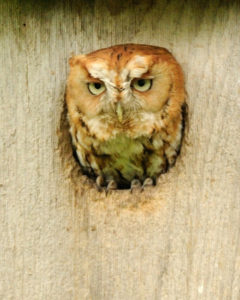
Adult red phase screech owl perches in 3″ hole of its nest box, note the feet gripping the edge of the opening.
Eastern screech owls come in two colors, a red phase and a gray phase. Its physical appearance, while perched, gives the impression it is missing the lower half of its body. During the day with its eyes shut it blends in so perfectly with its background it is difficult to tell what part is what. The owl seems to suddenly appear from the background when it opens its large yellow eyes.
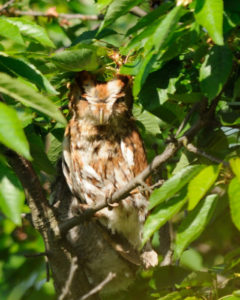
Eyes closed, these owls seems to disappear with no reference to top or bottom or recognizable form.
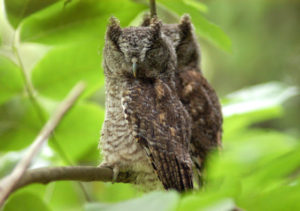
Screech owls seem to comfortably tolerate humans and can be seen, and will nest, in proximity to homes and buildings if a nest box is provided.
Late June early July, a screech owl would show up whenever I went into the backyard around dusk. It would follow me around and click its beak from a nearby branch. I have no idea what motivated that behavior but that owl provide plenty of photo opportunities.
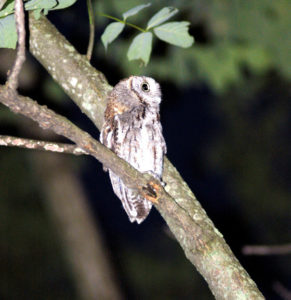
Then there were the memorable Christmas day visits. One Christmas morning I went to the open woodshed to replenish the woodstove with an armful of oak. There, staring me in the face from four feet away was a gray phase screech owl. It stayed put while I gathered the wood but was gone when I returned with my camera.
A few years later on Christmas night, a red phase screech owl perched a few feet off the ground in a weeping cherry tree. The little owl was spotted by the car’s headlights. It remained undisturbed while I did capture its image.
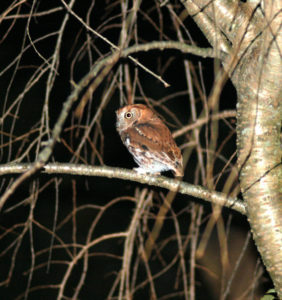
A late Christmas present in full feather, delivered at the front door.
Screech owls may just as well be found in deep woods. I have a great image of a red phase owl sitting in a healed hole in the side of a large tree trunk about eight feet off the ground. Other sightings have been in places where mature sycamore trees grow. Often, broken branches will leave a cavity that overtime becomes deeper, forming a perfect nest or day time resting place for this diminutive owl.
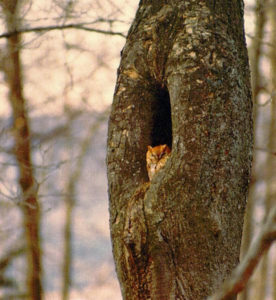
Though screech owls are quite common, you may never see one. Think of them as a night time radio host whose show you listen to all the time but never put a face to the voice. Hear a sampling of screech owl calls at: https://www.allaboutbirds.org/guide/Eastern_Screech-Owl/sounds
Author Joe Mish has been running wild in New Jersey since childhood when he found ways to escape his mother’s watchful eyes. He continues to trek the swamps, rivers and thickets seeking to share, with the residents and visitors, all of the state’s natural beauty hidden within full view. To read more of his writing and view more of his gorgeous photographs visit Winter Bear Rising, his wordpress blog. Joe’s series “Nature on the Raritan, Hidden in Plain View” runs monthly as part of the LRWP “Voices of the Watershed” series. Writing and photos used with permission from the author.
Our friend and “Voices of the Watershed: Pinelands of Helmetta” contributor Joe Sapia writes:
“Wow, I just heard a whip-poor-will calling at my house in the Helmetta Road area. That is the first time in about 6 years I have heard this bird, once a harbinger of spring in the local Pine Barrens, since about 2010.
Antrostomus vociferus is considered a jeopardized species in NJ. This one, I heard from about 10:45 p.m. to 11 p.m. Its call was powerful, meaning it was close, but it was sporadic, not the ad nauseam call.
Listen to an example and multiply that all night.
Around here, I would say this bird is a Pine Barrens bird, so it could be heard in parts of Monroe (north of Jamesburg and hugging the Old Bridge and Manalapan boundaries), anywhere in Helmetta and Spotswood, and other local Pine Barrens areas.
If you hear one locally, let me know when and the general location. Thanks.
A few weeks ago, I saw a brown thrasher, “Toxostoma rufum,” the first one I saw locally in years. What is going on?”
The Senate Environment and Energy Committee will meet on Monday, May 16th at 10am – the Committee has invited representatives from the NJ Department of Environmental Protection to discuss modifications to their proposed Flood Hazard Area Control Act Rules, Coastal Zone Management Rules, and the Stormwater Management Rules.
We encourage concerned stakeholders and citizens to come hear what NJDEP has to say about the changes they plan to make to their proposed revisions of the Flood Hazard rules.
WHEN: Mon., May 16th @ 10:00am
WHERE: State House Annex
125 W. State Street, Trenton NJ
Committee Room 10, 3rd Floor
By Elizabeth Dabundo and Heather Fenyk
Continuing the LRWP’s 2016 Natural Assets Mapping Speaker Series, on April 19 we welcomed Devin Gargan of AECOM and Nick Tufaro from the Middlesex County Office of Planning to discuss the topics of transportation and mobility assets in the Lower Raritan Watershed. Transportation is an important dimension of the concept of sustainability, and research into the environmental impacts of how we move to and from work, school and play involves everything from vehicle emissions to green supply chain management practices. Developing transportation systems for the future in a way that minimizes environmental impacts and maximizes environmental sustainability requires close study of the reciprocal influence between the physical environment and transport infrastructures, including careful analysis of geographical location, topography, geological structure, climate, hydrology, soil, natural vegetation and animal life.
Encouraging the use of mass transit through Transit Oriented Development, and encouraging non-motorized transportation through municipal planning that includes “Complete Streets” and a commitment to connectivity of pedestrian and bicycle networks, are both ways to reduce the negative environmental impacts of vehicular travel. Of course, however, there are also significant environmental impacts associated with the installation of new rail lines and tunnels. We discussed issues of sustainability as well as the potential environmental impacts of expanding our transportation infrastructure with Mr. Gargan and Mr. Tufaro. It was an extremely informative and interesting morning!
First, Devin Gargan of AECOM spoke about a recent planning exercise conducted by the Federal Rail Administration on the future of the Northeast Corridor Rail Line. (The completed report “NEC Future: A Rail Investment Plan for the Northeast Corridor” can be accessed here: http://www.necfuture.com/). The Northeast Corridor cuts through the Lower Raritan Watershed, connecting Boston to Washington DC. It spans 457 miles, carries 2,200 daily trains, and 750,000 daily passengers.
AECOM is working with the NEC, Federal Railroad Administration, Federal Transit Administration, communities along the rail line and others to upgrade aging infrastructure and improve reliability, capacity, performance, and resiliency of passenger rail service on the NEC for both intercity and regional trips, while promoting environmental sustainability and economic growth. Mr. Gargan presented on three alternatives to maintain, grow, or transform NEC rail service. In January the LRWP submitted written comments to AECOM highlighting the potential environmental impacts of these alternatives to the Raritan River and the Lower Raritan Watershed. While we acknowledged the environmental benefits of reducing vehicular miles travelled through expanded rail service, we emphasized the need to involve environmental stakeholders in Tier 2 Service Development Planning for any of the alternatives.

NEC Future Alternative 3, Lower Raritan Watershed. Image: AECOM
Alternative 1 maintains the role of rail as it is today, keeping pace w/ demographic change.
Alternative 2 grows the role of rail with service to new markets and more frequent intercity and regional trains looking at connecting markets. In central NJ Alternative 2 proposes a new rail segment that begins in North Brunswick and runs parallel to the NEC all the way to Seacaucus. This new segment includes creation of a tunnel running underneath the Raritan River between New Brunswick and Highland Park through to Metuchen and Edison.
Alternative 3 builds on Alternative 2 to transform the role of rail in the region with a second spine supporting faster trips and service to new markets, including an extension through North Brunswick.
AECOM is currently conducting Environmental Impact Statements (EIS) for each alternative, and plans to announce the preferred alternative in summer 2016 with Servive Development Plan exercises to being in 2017.
After Mr. Gargan’s very informative presentation, Nick Tufaro spoke about Middlesex County’s involvement with NJTransit and Together North Jersey’s “Planning Transit Friendly Places” projects. Planning Transit Friendly Places centers on Transit Oriented Development ((TOD) which, by its very nature, requires active collaboration among elected officials, transit planners, housing department professionals, private developers, philanthropic, leaders, community development financial institutions, and community advocates. Land use and transportation plays a vital role in nearly all other aspects of a community, like housing, business environment, energy and climate, and health and safety, so it is important to plan these transit friendly places to improve upon the community as a whole.
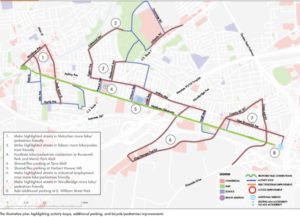
Middlesex Greenway Action Plan. Image: Middlesex County Office of Planning
Mr. Tufaro highlighted examples of Transit Oriented Development throughout the Lower Raritan Watershed, including the Middlesex Greenway Extension and Middlesex Greenway Access Plan, a large project that involves conversion of a former rail line into many miles of bicycle trails and park space for public use. Perth Amboy’s Bay City Transit District Strategy focused around the train station on Smith Street, and the Woodbridge-Rahway Regional Access to the Arts project. Other notable mobility and recreation assets projects in the Lower Raritan Watershed include the Raritan Riverwalk Trail in Perth Amboy, the Helmetta Pond Palling Trail, the Capik Nature Preserve Trail in Sayreville, and the Highland Park Meadows Trail. The LRWP is organizing field trips to several of these sites this year – please plan to join us for our first such outing – a picnic and tour of the Highland Park Meadows on June 2!
Rutgers Day is this Saturday April 30th! Stop by to spin the “Wheel of the Raritan” and to chat with the LRWP. This year we are sharing a table with Rutgers watershed management students and will be set-up in front of Blake Hall around Passion Puddle (Cook/Douglass Campus in New Brunswick).
Rutgers Day – held across all Rutgers campuses – starts at 10 am & runs until 4 pm. It is our favorite day of the year: friends, music, food, exhibits, tons of opportunities to learn new things – so much fun! Hope to see you Saturday!
Article and photos by Joe Mish
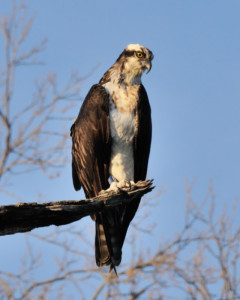
The osprey from Maine searches the clear water of the South Branch for a meal as she takes a break from her 2,500 mile journey north. The letters, DV, can be seen on the blue band attached to her right leg.
The warmth from the mid-morning sun felt good on my back as I paddled the low, clear water of the South Branch. The cloudless sky, directly above, was a darker shade of blue, its intensity pure and endless, and mesmerizing. It compelled me, as the devil’s advocate, to search for just a single speck to interrupt its perfection.
Suddenly a shadow sped across the water, momentarily stealing the sunlight. I instinctively looked up to catch a glimpse of an osprey circling above. The white head, streaked with a dark brown stripe, was instantly recognizable. The osprey proceeded downriver by making tight overlapping circles in its search for fish. It isn’t too hard to imagine some of these super intelligent predators realize a canoe is herding the fish ahead of it. When the osprey was about 150 yards downstream it tucked its wings and dove into foot deep water to come up with a large white sucker held fast in its black talons. The bird oriented the position of the fish to cut wind resistance as it flew out of sight.
Ospreys are ever present on the South Branch, typically from early spring to mid autumn. They feed primarily on live fish. I see them most often eating white suckers, a fish large enough to compensate for the energy spent to catch it.
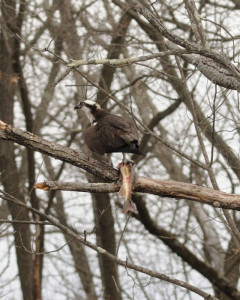
Osprey on a riverside perch, dining on fresh fish during the 2014 NJ opening day of trout season.
Earlier this April, I noticed an osprey perched in the same location day after day. This wasn’t typical of the local ospreys that ranged far and wide in their constant search for food. I was able to get a few photos and noticed a blue band on the right leg and a silver band on the left. I reported the band to the USGS website, BandReports@usgs.gov, to find this osprey was banded in Portland, Maine, July 27th, 2011 while it was still in the nest, too young to fly.
Osprey migrate from the northeast, where they breed, to central and South America each fall, a trip of more than 2,500 miles. This bird was apparently on its way back to Maine and stopped to rest. Osprey, like other migratory birds, are very loyal to nest sites and return to the same location with great predictability.
Consider our visiting osprey will be 5 years old this July, and has 25,000 plus, frequent flyer miles on its account, you have to recoil in amazement, wonder and respect for its strength and tenacity. As osprey can live 25 to 30 years or more, the mileage really adds up.
Our Maine visitor, a female, as evidenced by her speckled décolletage, has a bright and long future and hopefully will stop along the South Branch again on her journey to and from Central America. No doubt other osprey are flying to northern breeding grounds through NJ, so the opportunity to spot a banded bird along the North and South Branch are quite good.
The reporting of banded birds is critical to wildlife research as it helps to unravel the mystery of migration, the location of breeding grounds, longevity, and other variables that impact the health and status of local and overall wildlife populations.
New Jersey is now using red bands for osprey and from Ben Wurst at conservewildlifenj.org, as per USGS; “Green anodized bands are being used in NY. Purple anodized bands in MD and VA. Red anodized bands (like ours, but with alpha code A&B 00-99) in PA (permit is expired now). Blue anodized bands in MA, ME & Ontario.”
The preponderance of osprey nests in NJ are along the Delaware River and Atlantic shoreline, its estuaries, bays and rivers, so keep an eye out for banded birds and report them to BandReports@usgs.gov . The researchers are as excited about a band report as you and will send a certificate of appreciation with relevant data about your bird. Many species of birds are banded, so don’t forget our eagles, hawks and songbirds. Opportunities abound as NJ is on a major flyway, the rivers being main exit and entrance ramps to our backyard.
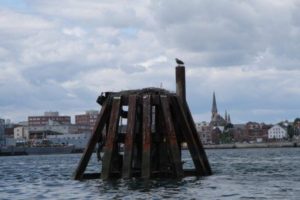
*Joe sent us an update to this post, a photo of the exact location in Maine where the osprey was born. Photo courtesy of Lauren Gilpatrick at the Biodiversity Research Institute, Portland Maine.
See, http://www.conservewildlifenj.org/education/ospreycam/ for more details about NJ osprey project and live osprey cam.
Special thanks to Robert Somes, Kathy Clark and Ben Wurst for their enthusiastic help and support.
Robert Somes, Senior Zoologist
NJ Division of Fish and Wildlife
Endangered and Nongame Species Program
Kathy Clark,CWB,
NJ Division of Fish and Wildlife
Endangered and Nongame Species Program,
Ben Wurst, Habitat Program Manager
New Jersey Osprey Project
Author Joe Mish has been running wild in New Jersey since childhood when he found ways to escape his mother’s watchful eyes. He continues to trek the swamps, rivers and thickets seeking to share, with the residents and visitors, all of the state’s natural beauty hidden within full view. To read more of his writing and view more of his gorgeous photographs visit Winter Bear Rising, his wordpress blog. Joe’s series “Nature on the Raritan, Hidden in Plain View” runs monthly as part of the LRWP “Voices of the Watershed” series. Writing and photos used with permission from the author.




























